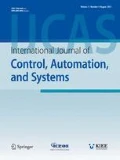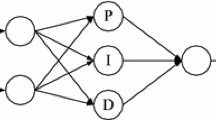Abstract
This article proposes an adaptive inverse evolutionary neural (AIEN) controller for liquid level control of the quadruple tank system. Firstly, an inverse evolutionary neural model (IEN) that is utilized for offline identifying a dynamics of quadruple tank system, provides a feed-forward control signal from the reference liquid level. In which, the evolutionary neural model is a 3-layers neural network that is optimized by a hybrid method of modified differential evolution and backpropagation algorithm. Then, a hybrid feedforward and PID feedback control is realized to eliminate the steady-state error. Finally, to solve an uncertainty and disturbance characteristic, an adaptive law is proposed to adopt online in its operation. Simulation and real-time control experimental results demonstrated the feasibility and effectiveness of the proposed approach for the quadruple-tank system.
Similar content being viewed by others
References
I. Mizumoto, D. Ikeda, T. Hirahata, and Z. Iwai, “Design of discrete time adaptive PID control systems with parallel feedforward compensator,” Control Eng. Pract., vol. 18. no. 2, pp. 168–176, 2010.
J. Kumar and A. K. Singh, “Workload prediction in cloud using artificial neural network and adaptive differential evolution,” Futur. Gener. Comput. Syst., vol. 81, pp. 41–52, 2018.
L. Wei, F. Fang, and Y. Shi, “Adaptive backstepping-based composite nonlinear feedback water level control for the nuclear U-tube steam generator,” IEEE Trans. Control Syst. Technol, vol. 22, no. 1, pp. 369–377, 2013.
K. H. Johansson, “The quadruple-tank process: a multi-variable laboratory process with an adjustable zero,” IEEE Trans. Control Syst. Technol., vol. 8, no. 3, pp. 456–465, 2000.
C. Bennani, F. Bedouhene, H. Bibi, A. Zemouche, R. Ra-jamani, K. Chaib-Draa, and A. Aitouche, “Robust H∞ observer-based stabilization of linear discrete-time systems with parameter uncertainties,” Int. J. Control Autom. Syst., vol. 17, no. 7, pp. 2261–2273, 2019.
S. Bououden, M. Chadli, and H. R. Karimi, “An ant colony optimization-based fuzzy predictive control approach for nonlinear processes,” Inf. Sci. (Ny)., vol. 299, pp. 143–158, 2015.
T. Wang, H. Gao, and J. Qiu, “A combined adaptive neural network and nonlinear model predictive control for mul-tirate networked industrial process control,” IEEE Trans. Neural Networks Learn. Syst., vol. 27, no. 2, pp. 416–425, 2015.
M. Cetin, B. Bahtiyar, and S. Beyhan, “Adaptive uncertainty compensation-based nonlinear model predictive control with real-time applications,” Neural Comput. Appl, vol. 31, no. 2, pp. 1029–1043, 2019.
A. Thamallah, A. Sakly, and F. M’Sahli, “A new constrained PSO for fuzzy predictive control of Quadruple-Tank process,” Measurement, vol. 136, pp. 93–104, 2019.
J. Yu, H. Dang, and L. Wang, “Fuzzy iterative learning control-based design of fault tolerant guaranteed cost controller for nonlinear batch processes,” Int. J. Control. Autom. Syst., vol. 16, no. 5, pp. 2518–2527, 2018.
M. Kawato, “Feedback-error-learning neural network for supervised motor learning,” Adv. neural Comput., vol. 6, no. 3, pp. 365–372, 1990.
K. Sabahi, S. Ghaemi, and M. A. Badamchizadeh, “Feedback error learning-based type-2 fuzzy neural network predictive controller for a class of nonlinear input delay systems,” Trans. Inst. Meas. Control, 2019. DOI: 10.1177/0142331219834998
C. Zhang and J. Li, “Adaptive iterative learning control for nonlinear pure-feedback systems with initial state error based on fuzzy approximation,” J. Franklin Inst., vol. 351, no. 3, pp. 1483–1500, 2014.
A. Rawat and M. J. Nigam, “Feedback error based discontinuous and continuous variable learning rate CMAC,” Int. J. Electron. Electr. Eng, vol. 3, no. 4, pp. 305–310, 2014.
K. Sabahi and M. Teshnehlab, “Recurrent fuzzy neural network by using feedback error learning approaches for LFC in interconnected power system,” Energy Convers. Manag., vol. 50, no. 4, pp. 938–946, 2009.
H. Zhao, H. Liu, J. Xu, and W. Deng, “Performance prediction using high-order differential mathematical morphology gradient spectrum entropy and extreme learning machine,” IEEE Trans. Instrum. Meas., 2019. DOI: 10.1109/TIM.2019.2948414
A. P. Piotrowski, “Differential evolution algorithms applied to neural network training suffer from stagnation,” Appl. Soft Comput., vol. 21, pp. 382–406, 2014.
M. Mohammadi, M. Lakestani, and M. H. Mohamed, “Intelligent parameter optimization of Savonius rotor using artificial neural network and genetic algorithm,” Energy, vol. 143, pp. 56–68, 2018.
A. A. Alnaqi, H. Moayedi, A. Shahsavar, and T. K. Nguyen, “Prediction of energetic performance of a building integrated photovoltaic/thermal system thorough artificial neural network and hybrid particle swarm optimization models,” Energy Convers. Manag., vol. 183, pp. 137–148, 2019.
I. Aljarah, H. Faris, and S. Mirjalili, “Optimizing connection weights in neural networks using the whale optimization algorithm,” Soft Comput, vol. 22, no. 1, pp. 1–15, 2018.
A. ElSaid, F. El Jamiy, J. Higgins, B. Wild, and T. Desell, “Optimizing long short-term memory recurrent neural networks using ant colony optimization to predict turbine engine vibration,” Appl. Soft Comput., vol. 73, pp. 969–991, 2018.
W. Deng, J. Xu, and H. Zhao, “An improved ant colony optimization algorithm based on hybrid strategies for scheduling problem,” IEEE Access, vol. 7, pp. 20281–20292, 2019.
W. Deng, H. Zhao, L. Zou, G. Li, X. Yang, and D. Wu, “A novel collaborative optimization algorithm in solving complex optimization problems,” Soft Comput., vol. 21, no. 15, pp. 4387–4398, 2017.
A. Anand and L. Suganthi, “Hybrid GA-PSO optimization of artificial neural network for forecasting electricity demand,” Energies, vol. 11, no. 4, p. 728, 2018.
R. Storn and K. Price, “Differential evolution-a simple and efficient heuristic for global optimization over continuous spaces,” J. Glob. Optim., vol. 11, no. 4, pp. 341–359, 1997.
B. Subudhi and D. Jena, “A differential evolution based neural network approach to nonlinear system identification,” Appl. Soft Comput., vol. 11, no. 1, pp. 861–871, 2011.
T. J. Choi, J.-H. Lee, H. Y. Youn, and C. W. Ahn, “Adaptive differential evolution with elite opposition-based learning and its application to training artificial neural networks,” Fundam. Informaticae, vol. 164, no. 2–3, pp. 227–242, 2019.
S. N. Nguyen, V. Ho-Huu, and A. P. H. Ho, “A neural differential evolution identification approach to nonlinear systems and modelling of shape memory alloy actuator,” Asian J. Control, vol. 20, no. 1, pp. 57–70, 2018.
N. Ngoc Son, H. P. H. Anh, and N. Thanh Nam, “Robot manipulator identification based on adaptive multiple-input and multiple-output neural model optimized by advanced differential evolution algorithm,” Int. J. Adv. Robot. Syst.,vol. 14, no. 1, 2016. DOI: 10.1177/1729881416677695
N. N. Son, H. P. H. Anh, and T. D. Chau, “Adaptive neural model optimized by modified differential evolution for identifying 5-DOF robot manipulator dynamic system,” Soft Comput., vol. 22, no. 3, pp. 979–988, 2018.
M. Wang, J. Luo, J. Fang, and J. Yuan, “Optimal trajectory planning of free-floating space manipulator using differential evolution algorithm,” Adv. Sp. Res., vol. 61, no. 6, pp. 1525–1536, 2018.
J. Nakanishi and S. Schaal, “Feedback error learning and nonlinear adaptive control,” Neural Networks, vol. 17, no. 10, pp. 1453–1465, 2004.
X. Ruan, M. Ding, D. Gong, and J. Qiao, “On-line adaptive control for inverted pendulum balancing based on feedback-error-learning,” Neurocomputing, vol. 70, no. 4–6, pp. 770–776, 2007.
K. Sabahi, S. Ghaemi, and S. Pezeshki, “Application of type-2 fuzzy logic system for load frequency control using feedback error learning approaches,” Appl. Soft Comput., vol. 21, pp. 1–11, 2014.
K. Kurosawa, R. Futami, T. Watanabe, and N. Hoshimiya, “Joint angle control by FES using a feedback error learning controller,” IEEE Trans. Neural Syst. Rehabil. Eng., vol. 13, no. 3, pp. 359–371, 2005.
Author information
Authors and Affiliations
Corresponding author
Additional information
Publisher’s Note Springer Nature remains neutral with regard to jurisdictional claims in published maps and institutional affiliations.
Recommended by Associate Editor Quoc Chi Nguyen under the direction of Editor-in-Chief Keum-Shik Hong. This work was supported by the National Foundation for Science and Technology Development (NAFOSTED), under grant number MDT: 107.01-2018.318, Viet Nam. Supporting informations are available online at (https://youtu.be/PuARVJeQSac) and (https://drive.google.com/open?id=lmybyrhHiBvJtx3tSQzUz7hvLlYdTN2xL).
Nguyen Ngoc Son received his Ph.D. degrees from Ho Chi Minh City University of Technology in 2017. He is currently a Vice-Dean of the Faculty of Electronics Technology, Industrial University of Ho Chi Minh City, Viet Nam. His current research interests include artificial intelligence, robotics, identification, and intelligent control, internet of things.
Rights and permissions
About this article
Cite this article
Son, N.N. Level Control of Quadruple Tank System Based on Adaptive Inverse Evolutionary Neural Controller. Int. J. Control Autom. Syst. 18, 2386–2397 (2020). https://doi.org/10.1007/s12555-019-0504-8
Received:
Revised:
Accepted:
Published:
Issue Date:
DOI: https://doi.org/10.1007/s12555-019-0504-8



